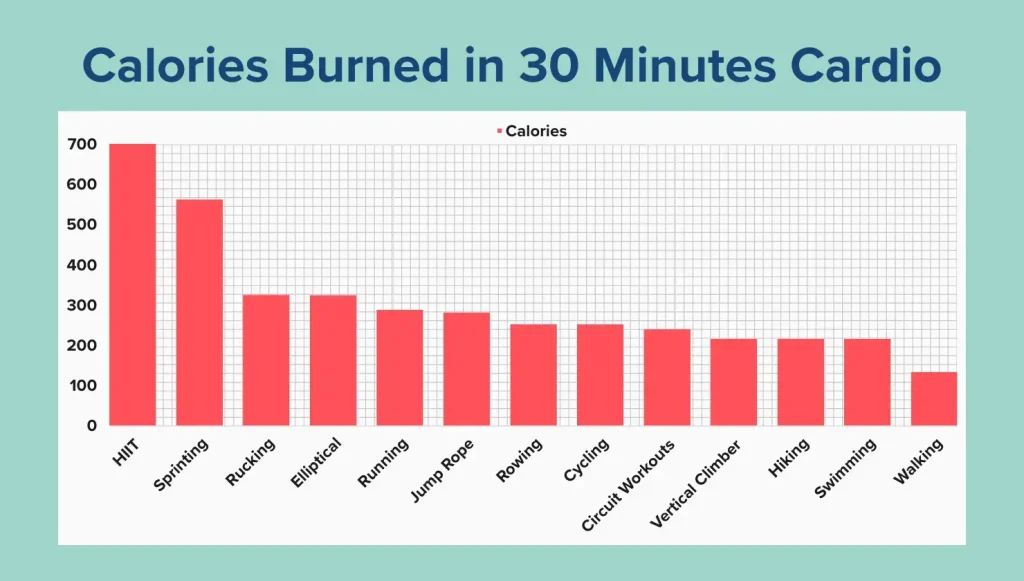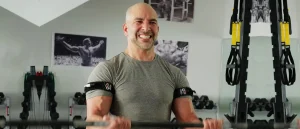This Is the Best Cardio for Weight Loss, According to a Personal Trainer
- By Sydney Bueckert, NASM C.P.T., C.E.S., F.N.S., G.P.T.S.
- November 16, 2023
30-Second Takeaway
- Cardio burns calories, and thus, can help with weight loss efforts.
- HIIT, sprinting, running, rucking (walking with a weighted backpack), or the elliptical are your best options for maximizing calorie burn.
- While some types of cardio burn more calories than others, it’s your overall calorie deficit that results in weight loss. So, find an activity or two you enjoy, and do it often and consistently for best results.
When you set out to lose weight, your mission typically starts in the same old familiar place: Cardio, and lots more of it. Since cardio is particularly effective at burning calories, it can help you shed pounds. But some types of cardio are better for weight loss than others.
We tapped personal trainer and nutrition coach James King III, CSCS, PN-1 to find out the best cardio for weight loss, how much you need, and what other variables you might need to tweak to move the needle.
Does Cardio Help You Lose Weight?
It can. Losing weight comes down to being in a calorie deficit—in other words, burning more calories than you consume. To achieve a calorie deficit you can adjust your diet, exercise, or both. One study found that consistent aerobic exercise alone (without restricting calories) resulted in significant weight loss (1). But according to King, the best approach tends to combine the two.
“Combining calorie reduction with exercise is more effective for weight loss because it creates a larger calorie deficit, preserves muscle mass while burning fat, and improves overall metabolic health,” explains King. This dual approach also ensures sustainable weight loss by promoting long-term health benefits, a win-win.
How Much Cardio Do You Need to Lose Weight?
It depends. In general, the American Heart Association recommendations of at least 150 minutes of moderate aerobic activity or 75 minutes of vigorous aerobic activity a week is a solid place to start (2). But according to the American College of Sports Medicine, some people might need close to double that (200 to 300 minutes of moderate-intensity exercise) for long-term weight loss (3). Where your time input should fall depends on a variety of factors.
“A beginner may see results with less cardio, while someone more conditioned might need longer or more intense sessions,” says King. You might also need more cardio (along with additional dietary tweaks) if your weight loss goal is more substantial, you have a slower metabolism, or you tend to be more sedentary throughout the day.
King recommends starting with more achievable targets—like 10 to 15 minutes a day—and gradually increasing the duration as your fitness improves. It also wouldn’t hurt to be more active throughout the day. For example, standing instead of sitting, walking while talking on the phone, taking the stairs instead of the elevator, etc. “Movement throughout the day adds up and can easily be the difference between making progress and not making progress,” says King.
Best Cardio for Weight Loss
When it comes to cardio for weight loss, you really can’t go wrong. In fact, King recommends mixing it up to reduce the risk of overuse injuries, boost overall fitness, and enhance weight loss. Still, we’ve ranked the best cardio workouts for weight loss by calories burned per session, below.

1. HIIT
High-intensity interval training (or HIIT for short) involves alternating short periods of all-out exercise with longer bouts of rest. It’s fast, it’s fun, and you won’t find a more efficient workout for burning calories. The best part is you can apply HIIT to basically any form of cardio you like. Just intersperse periods of high-effort work on a rowing machine, bike, treadmill, etc. with rest. All said and done, most HIIT sessions take only 20 to 30 minutes from start to finish. Just make sure you’re getting adequate rest between sessions, the high-intensity nature of this workout requires more rest than steady-state cardio.
Average calorie burn in 30 minutes: 390-700 calories (4)
The benefits: Insanely efficient, fast-paced, challenging
2. Sprinting
As one of the most popular forms of HIIT, it’s no secret that sprinting sears calories. Studies have shown that sprinting can also lower your risk of all-cause mortality (5). That said, sprinting ain’t easy. The faster you go, the more running form generally starts to break down. Running with bad form increases your risk of injury—which can quickly derail your weight loss efforts. If your form is lacking, taper to a pace where you can comfortably run with good form, or stick to an activity you feel more comfortable going all-out, like cycling.
Average calorie burn in 30 minutes: 562 calories (6)
The benefits: Fun, quick, skyrockets athleticism
3. Rucking
Rucking, or walking with a weighted pack on your back, is a staple of military training that helps troops get (and stay) fighting fit. But you don’t need to be a Green Beret to reap the benefits. Rucking takes the average person and toughens them—a stronger heart and muscles, and more resilient joints. It’s lower impact than running, and the extra weight dials up the intensity of a normal walk. Most importantly, it’ll kick your ass.
Average calorie burn in 30 minutes: 325 calories (7)
The benefits: Functional, doubles as time in nature, can be done anywhere a backpack can be worn
4. Elliptical
The elliptical, the pinnacle of absentminded cardio workouts, is a surprisingly effective, calorie-torching workout. Why? Likely because ellipticals target nearly all of the major muscle groups in your body at once. And the more muscles you work, generally the more energy your body needs to complete that movement—burning more calories in the process. The elliptical is also uniquely both weight-bearing (which helps increase the strength of your bones) and low-impact (reducing the wear and tear on your joints).
Average calorie burn in 30 minutes: 324 calories (6)
The benefits: Full body, low-impact, good for cruising on auto-pilot
5. Running
There are two types of people in this world: Runners and people who would sooner get a root canal before being caught pounding the pavement. If you’re the latter, skip it. Running is one of the best ways to burn calories; but, choosing a form of cardio that you enjoy will make it easier to be consistent, says King. If you do love running, great. Just don’t forget to vary your schedule with other forms of cross-training. Running is high impact and puts a high volume of repetitive force on your muscles and joints. Mixing it up will help reduce the strain on your body and lessen your risk of injury.
Average calorie burn in 30 minutes: 288 calories (6)
The benefits: Endorphin-boosting, rewarding, addictive
6. Jumping rope
For a workout that requires little space and buy-in, consider jump roping. You can snag a jump rope for cheap (this highly-rated jump rope is only nine bucks on Amazon). Jump roping burns a solid amount of calories. Plus, it’s a fun skill that will build your functional fitness, reaction time, and agility. The downside: Jump roping is challenging enough that it’d be tough to get enough cardio in each week just jump roping. Odds are good you aren’t going to jump rope for 30 minutes straight. Still, it’s a solid way to mix up your routine throughout the week.
Average calorie burn in 30 minutes: 281 calories (6)
The benefits: Boost speed and agility, increase functional fitness, master a new skill
7. Rowing
Like the elliptical, rowing works the majority of the muscles in your body—86 percent of them to be exact. Because it recruits all of your major muscle groups to complete one full stroke, it simultaneously utilizes more of your aerobic capacity (burning more calories in the process). Rowing is also low-impact, making it a good option for recovery workouts or cross-training. Bonus: It’s one of the few cardio workouts that hammers your upper body. Stick with it and you can expect stronger arms and back muscles in no time.
Average calorie burn in 30 minutes: 252 calories (6)
The benefits: Full body, low-impact, rhythmic
8. Cycling
Cycling is one of the best ways to get your cardio in without overloading your joints. It’s accessible and fun. And between spin classes, road cycling, and classic churn-and-burn on the stationary bike, there’s a little something for everyone. If you’re new to cardio, cycling is forgiving so long as you don’t slouch your back while you ride. You’ll mostly work your legs and your core, which gives you the opportunity to hone in on perfecting your posture as you pedal away.
Average calorie burn in 30 minutes: 252 calories (6)
The benefits: Joint-friendly, a solid pick for most injuries, can easily shift from low- to high-intensity
9. Circuit workouts
Circuit workouts are a triple whammy for calorie burn. Since you’ll maximize the muscles worked by stacking back-to-back compound exercises, you can expect to burn a solid amount of calories during your workout. Since circuit training is essentially the intersection between high-intensity cardio and strength, it also taps into excess post-exercise oxygen consumption (or EPOC)—when your body burns more calories after a workout to recover, repair, and return to its pre-exercise state. One study found that strength training and high-intensity cardio training are more effective for triggering EPOC than steady-state cardio (8). Finally, circuit training builds muscle. Muscle mass increases your metabolism at rest—meaning you’ll burn more calories even when you aren’t working out.
Average calorie burn in 30 minutes: 240 calories (6)
The benefits: Builds muscle, versatile, no two workouts are the same
10. StairMaster or Vertical Climber
Many people consider the StairMaster the king of calorie burn, and it does a decent job of burning calories. To burn even more, hop on a vertical climber. Imagine scaling a mountain by hand and foot but with way more predictable footing—that’s a vertical climber. It’s hard as hell (obviously), but comes with loads of benefits. If you’re someone with joint pain or frequently have recovery periods between races or athletic competitions, vertical climbers are an excellent option. Their best attribute is the ability to recruit nearly the entire body for high-intensity cardio work without stressing the joints.
Average calorie burn in 30 minutes: 216 calories (6)
The benefits: Low impact, hard as hell, steep set incline significantly increases lower body muscle activation
11. Hiking
If you’re the outdoorsy type, hiking is the obvious choice. The calories burned by hiking is extremely variable, as trails can range from flat and breezy to mountain summits. The harder you hike, more consistently you move, and the faster you move, the more you’ll burn. Regardless of how hard you hike, one of the biggest benefits of hiking is the uneven ground—it’ll strengthen the intrinsic muscles in your feet and ankles, which makes you more stable in everyday life and at the gym.
Average calorie burn in 30 minutes: 216 calories (6)
The benefits: Good for all levels, gets you outside, can be as intense as you make it
12. Swimming
Swimming is an often-forgotten form of cardio. It’s incredibly good for you, as it’s no impact (a benefit other activities on this list can’t claim) and involves your entire body to get the job done. That said, there are downsides. First, you need access to a pool (duh). And if you only have access to an outdoor pool, inclement weather can ruin your plans. If you can get past these obstacles, swimming is like riding a bike—it’s a sport that’ll stick with you forever.
Average calorie burn in 30 minutes: 216 calories (6)
The benefits: Easy on your body, no impact, highly functional
13. Walking
Walking isn’t the best for burning calories, but it is insanely practical and accessible to most people. Even if you’re stuck indoors, walking pads are relatively cheap. One of the best things about walking is it’s easy on your body. So if you burn out on other exercise, or you’re too tired or sore to do your planned workout, walking is the perfect fallback. It’s also a workable starting point. So, if you aren’t ready for more intense cardio workouts, or you’ve fallen off your workout schedule, you can always come back to it. It should be noted that you can easily notch up the intensity of walking by increasing the incline. Walking on an incline ups the challenge on the muscles of your lower body, and can thus burn more calories.
Average calorie burn in 30 minutes: 133 calories (6)
The benefits: Practical, free, no need to learn a new skill or good form—just move
FAQs on Cardio for Weight Loss
You’ve got questions about cardio for weight loss, we’ve got answers.
Can cardio burn belly fat?
Yes. Studies show exercise reduces visceral fat (the particularly harmful layer of fat that accumulates in your abdomen) in a dose-dependent manner (9). In other words, the more exercise you do, the more belly fat you lose.
Does cardio or strength training burn more fat?
In general, cardio is better for burning calories than strength training. However, a combination of strength and cardio can be more effective for fat loss. Why? Aerobic training alone can reduce lean muscle mass (10), giving up muscle for precious energy. The problem is muscle plays an important role in metabolism; lose muscle and your metabolism slows to a crawl (11). By doing a combo of cardio and strength training, you can keep your metabolism humming by maintaining and building muscle, while simultaneously burning loads of calories through your cardio sessions, per King.
Is high-intensity cardio better for weight loss?
Not necessarily. High-intensity cardio can help you burn more calories in a shorter amount of time, but it’s also harder on your body. Which means you’ll need more rest between workouts. The problem: Weight loss is a consistency game.
Think about it: If you can only muster the energy for two 20-minute HIIT workouts per week, but can easily handle five, 30-minute moderate-intensity workouts, the moderate-intensity workouts are probably the better option for weight loss. Even though they likely burn fewer calories per session than their high-intensity counterparts, collectively they can make a bigger impact on your overall calorie deficit.
King recommends using high-intensity cardio as a tool. Vary your cardio intensity throughout the week to help you burn enough calories to lose weight.
Is 30 minutes of cardio a day enough to lose weight?
Maybe. “Yes, 30 minutes of cardio per day can be enough to lose weight, especially if it’s done consistently and combined with a healthy diet,” says King. “However, individual results vary based on factors like diet, workout intensity, non-exercise activity throughout the day, and metabolism.”
The key is to ensure that the cardio is of moderate to vigorous intensity to effectively burn calories. Prioritizing cardio variety and adding in strength training can also help to enhance your weight loss efforts and overall fitness. If you still aren’t seeing results, adjust your routine as needed to meet your specific goals, or work with a personal trainer to figure out the perfect routine for you.
The Bottom Line
Cardio burns calories, and thus, help with weight loss efforts. Some types of cardio burn more calories than others. In general, the higher the intensity, the more calories you burn. HIIT, sprinting, running, rucking (walking with a weighted backpack), or the elliptical are your best options for maximizing calorie burn. That said, varying your intensity throughout the week will help maximize calorie burn, boost fitness, and reduce your risk of injury—supporting long-term weight loss and overall health.
About the Expert:
After living an unhealthy lifestyle for several years, James King III was more than 50 pounds overweight and lacked confidence. At his lowest moment, it was difficult for him to even look in the mirror. After implementing many of the same strategies and systems he now shares with his clients, he lost over 50 pounds. And kept it off for good. More importantly, he regained his confidence and felt like himself again. Since transforming his health, he has dedicated his life to helping others experience the same changes he experienced through his own personal transformation.
References
1. Donnelly, J. et al. (2013). Aerobic Exercise Alone Results in Clinically Significant Weight Loss or Men and Women: Midwest Exercise Trial 2.
2. American Heart Association (2023). American Heart Association Recommendations for Physical Activity in Adults and Kids.
3. Donnelly, J. et al. (2009). Appropriate Physical Activity Intervention Strategies for Weight Loss and Prevention of Weight Regain for Adults.
4. Thompson, W. et al. (2019). Worldwide Survey of Fitness Trends for 2020.
5. Stensvold, D. et al. (2020). Effect of Exercise Training for Five Years on All Cause Mortality in Older Adults—the Generation 100 Study: Randomized Controlled Trial.
6. Harvard Medical School (2021). Calories Burned in 30 Minutes for People of Three Different Weights.
7. Ainsworth, B. et al. (2011). 2011 Compendium of Physical Activities: a Second Update of Codes and MET Values.
8. Greer, B. et al. (2014). EPOC Comparison Between Isocaloric Bouts of Steady-State Aerobic, Intermittent Aerobic, and Resistance Training.
9. Recchia, F. et al. (2022). Dose-Response Effects of Exercise on Caloric Restriction n Visceral Adiposity in Overweight and Obese Adults: A Systematic Review and Meta-Analysis of Randomised Controlled Trials.
10. Bellicha, A. et al. (2021). Effect of Exercise Training on Weight Loss, Body Composition Changes, and Weight Maintenance in Adults with Overweight or Obesity: An Overview of 12 Systematic Reviews and 149 Studies.
11. Wang, Z. e tal. (2010). Specific Metabolic Rates of Major Organs and Tissues Across Adulthood: Evaluation by Mechanistic Model of Resting Energy Expenditure.

















